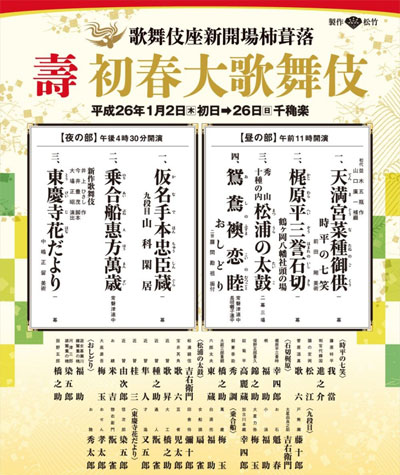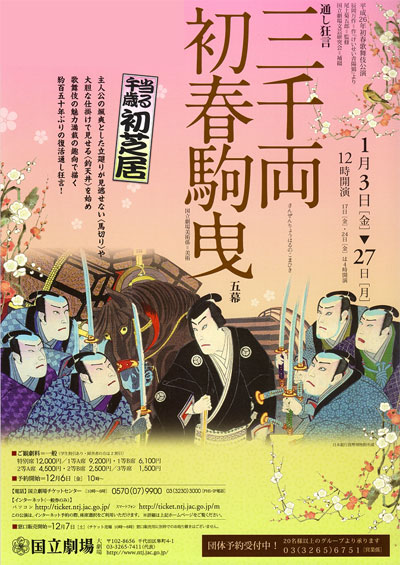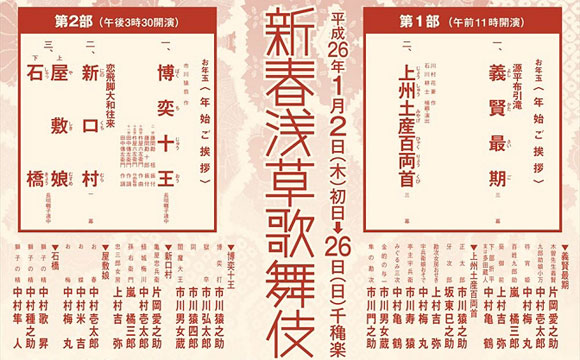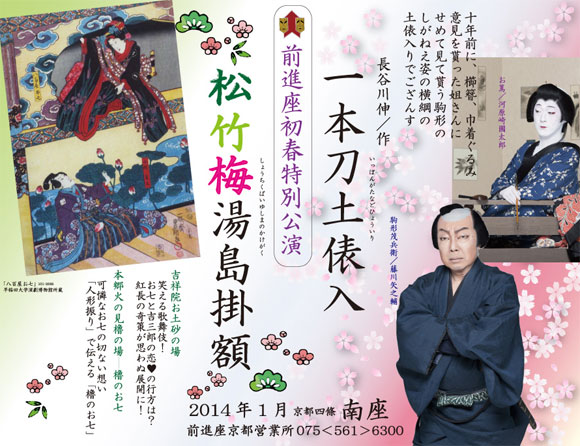| JANUARY 2014 |
|
1 in ďsaka (Sh˘chikuza), 6 shows in T˘ky˘ (Kabukiza, National Theatre, Asakusa K˘kaid˘, Shinbashi Enbuj˘) and 1 show in Ky˘to (Minamiza)!
|
| Kabukiza (T˘ky˘) |  |
| Dates | 2 ~ 26 January 2014 (Kokera Otoshi Kotobuki Hatsuharu ďkabuki) Opening Ceremony Congratulation Early Spring Grand Kabuki |
| MatinÚe |
Tenmangű Natane no Gokű |
| Evening |
Kanadehon Chűshingura T˘keiji Hanadayori |
| Casting |
Sakata T˘jűr˘, Nakamura Kichiemon, Matsumoto K˘shir˘, Nakamura Baigyoku, Nakamura Hashinosuke, Nakamura Kanjaku, Kataoka Gat˘, Kataoka Hidetar˘, Nakamura Senjaku, Nakamura Fukusuke, Nakamura Kaishun, Kataoka Takatar˘, Nakamura Kinnosuke, Ichikawa Somegor˘, Band˘ Yajűr˘, Nakamura Karoku, Nakamura Matagor˘, Nakamura T˘z˘, Ichikawa Komaz˘, Band˘ Shűch˘, Nakamura Kash˘, Kataoka Shinnosuke, Sawamura Yoshijir˘, Nakamura Matsue, ďtani Keiz˘, Nakamura Kotar˘, Nakamura Yonekichi, Nakamura Tanenosuke, Nakamura Hayato |
| Comments |
10th month celebrating the opening of the new Kabukiza within a 1-year long cycle of kokera otoshi programs.
|
 |
| National Theatre (T˘ky˘) |
| Dates | 3 ~ 27 January 2014 |
| Program |
Sanzen Ry˘ Haru no Komahiki |
| Casting |
Onoe Kikugor˘, Nakamura Tokiz˘, Onoe Kikunosuke, Onoe Sh˘roku, Sawamura Tanosuke, Ichikawa Danz˘, Band˘ Hikosabur˘, Kawarasaki Gonjűr˘, Ichimura Manjir˘, Band˘ Kamesabur˘, Band˘ Kametoshi, Onoe Matsuya, Nakamura Baishi, Onoe Ukon, Ichimura Takematsu, Fujima Taiga |
| Comments |
Tatsuoka Mansaku's drama "Keisei Haru no Tori", which is famous for the "Umagiri" scene, is revived at the National Theatre as a t˘shi ky˘gen in 5 acts (9 scenes), which is entitled "Sanzen Ry˘ Haru no Komahiki". The "Umagiri" scene, a scene where a horseman is cut down with a single slash by Oda Nobutaka at the Yamato bridge, is still part of the current Kabuki repertoire but it is not often performed. The stars of "Sanzen Ry˘ Haru no Komahiki" are Living National Treasure Onoe Kikugor˘, Nakamura Tokiz˘, Onoe Kikunosuke and Onoe Sh˘roku. This revival features also Living National Treasure Sawamura Tanosuke [more details]. By the way, 2014 is the Year of the Horse in the traditional calendar. |
 |
| Sh˘chikuza (ďsaka) |
| Dates | 2 ~ 27 January 2014 (Hatsuharu Tokubetsu Buy˘ K˘en) Early Spring Special Dance Performances |
| Program |
Mura no Matsukaze Ninin Shiokumi Ninin Fuji Musume Osome Hisamatsu Ukina no Yomiuri |
| Casting |
Band˘ Tamasabur˘, Nakamura Shichinosuke, Band˘ Shinsha, Ichikawa En'ya, Ichikawa Emisabur˘, Ichikawa Tsukinosuke |
| Comments |
A special new year dance program at the Sh˘chikuza starring Living National Treasure Band˘ Tamasabur˘:
|
| Shinbashi Enbuj˘ (T˘ky˘) |
| Dates | 1 ~ 25 January 2014 (Hatsuharu Hanagata Kabuki) Early Spring Young Actors Kabuki |
| Program | |
| Casting |
Ichikawa Ebiz˘, Nakamura Shibajaku, Ichikawa Sadanji, Nakamura Shid˘, ďtani Tomoemon, Kataoka Ichiz˘, Ichikawa Unosuke, Ichimura Kakitsu, Band˘ Shingo, Nakamura Mantar˘, ďtani Hiromatsu |
| Comments |
This drama presents the world of Akushichiby˘e Kagekiyo with new perspectives. He was a warrior in 12th century and famous for the episode in "The Tale of Heike" which depicts Heike clan at the height of its prosperity, its defeat to the Genji clan and its downfall. Aku in his name means bravery which he demonstrates in wars against the Genji clan. Many legendary stories have been passed down about him as a rebellious hero: He is said to have planned to overthrow the Genji clan even after the downfall of the Heike clan and have tried to assassinate the Genji general Minamoto no Yoritomo 37 times. His mysterious stormy life is taken up as an attractive material in many genres such as N˘, Bunraku and Kabuki. Kagekiyo appears in 4 of the collection of the Eighteen Favorite Plays of the Ichikawa Family (Kabuki Jűhachiban): "Kan U", "Kagekiyo" "Kamahige" and "Gedatsu". Ichikawa Ebiz˘, who is struggling energetically to revive and success it, will fascinate you with aragoto bombastic style of acting which is unique for it. Please look forward to a gorgeous stage which is typical of New Year. Featuring Nakamura Shibajaku, Nakamura Shid˘ and Ichikawa Sadanji in the roles of Akoya (Kagekiyo's lover), Chichibu no Sh˘ji Shigetada (Kagekiyo's enemy) and Mionoya Shir˘. |
|
|||
| Dates | 2 ~ 26 January 2014 (Shinshun Hanagata Kabuki) New Year Young Actors Kabuki |
||
| MatinÚe |
Otoshidama (Nenshi Goaisatsu) |
||
| Evening |
Otoshidama (Nenshi Goaisatsu) Bakuchi Jű˘ |
||
| Casting |
Ichikawa Ennosuke, Kataoka Ainosuke, Nakamura Kikaku, Band˘ Minosuke, Nakamura Kazutar˘, Kamimura Kichiya, Ichikawa Monnosuke, Ichikawa Omez˘, Ichikawa Juen, Arashi Kitsusabur˘, Nakamura Kash˘, Ichikawa K˘tar˘, Nakamura Umemaru, Nakamura Hayato, Nakamura Tanenosuke, Nakamura Yonekichi, Ichikawa Enshir˘ |
||
| Comments |
The yearly show for young promising actors at the Asakusa K˘kaid˘ in Asakusa, a lively and colorful neighboorhood that keeps the scent of old Edo.
|
||
 |
|
|||
| Dates | 4 ~ 17 January 2014 (Zenshinza Hatsuharu Tokubetsu K˘en) Zenshinza Early Spring Special Performances |
||
| Program | |||
| Casting |
Kawarasaki Kunitar˘, Fujikawa Yanosuke, Arashi Yoshisabur˘, Yamazaki Tatsusabur˘ |
||
| Comments |
The traditional Zenshinza New Year performances at the Minamiza:
|
||
 |
|
|
| Contact | Main | Top | Updates | Actors | Plays | Playwrights | Programs | Links | FAQ | Glossary | Chronology | Illustrations | Prints | Characters | Derivatives | Theaters | Coming soon | News |